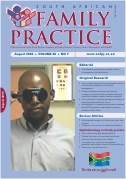Office skills for the general practitioner
Abstract
Eye disorders are relatively common. Often the initial presentation is to a general practitioner. With a few basic tools for eye examination, a general practitioner would be able to conduct an adequate ophthalmic examination and appropriately refer cases requiring specialist care. Assessment of visual acuity using a snellen chart and a pinhole can exclude refractive errors. A penlight is an inexpensive yet indispensable tool in the assessment of pupillary response, external structures as well as the anterior segment of the eye. Superficial ocular foreign bodies are relatively common. With a good technique for eyelid eversion, these foreign bodies can be easily removed. Using fluorescein stain and cobalt blue light one can appreciate corneal epithelial defects. Glaucoma is a sight threatening condition that can be effectively screened for, by using a schiotz tonometer and appropriate referrals made if the intraocular pressure is > 21 mmHg or if the optic disc is cupped. Direct ophthalmoscopy may be difficult but with a systematic approach and a few simple guidelines one would be able to adequately evaluate the posterior segment. SA Fam Pract 2006;48(7): 20-26
Section
CPD
By submitting manuscripts to SAFP, authors of original articles are assigning copyright to the South African Academy of Family Physicians. Copyright of review articles are assigned to the Publisher, Medpharm Publications (Pty) Ltd, unless otherwise specified. Authors may use their own work after publication without written permission, provided they acknowledge the original source. Individuals and academic institutions may freely copy and distribute articles published in SAFP for educational and research purposes without obtaining permission.

